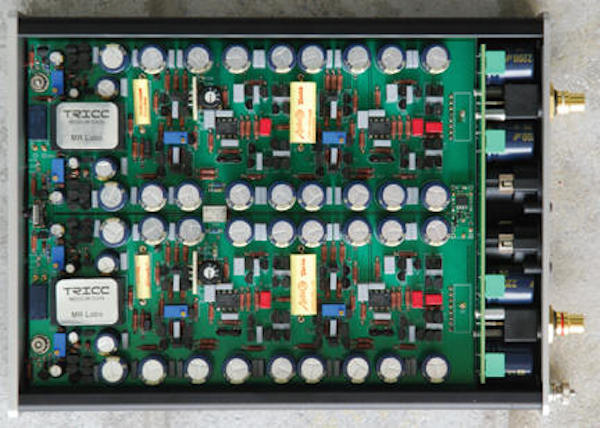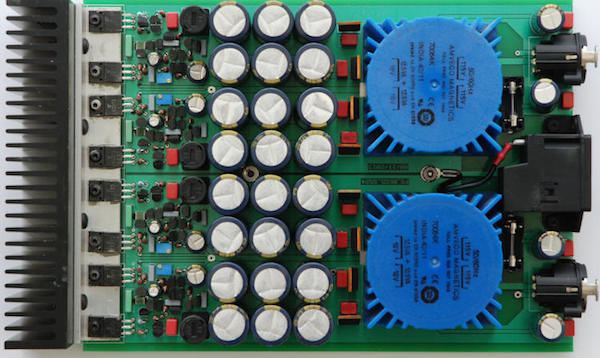Is the statement mono cartridges need not apply so obvious to everyone other then me?
How do current Transfiguration cartridges fare with this product?
Sorry in advance for my ignorance. I worked hard to earn it.
It consists of two relatively small chassis, one containing the amplification and signal processing electronics and the other the power supply. The power supply chassis (which at approximately 6 pounds weighs 3 times more than the amplification chassis) is capped at one end with a beefy heat sink more typical of a power amplifier. The two chassis connect via a pair of multi-pin umbilicals.
Like the approximately $4000 B.M.C. Phono MCCI phono preamplifier reviewed in Stereophile in June of 2013, the first stage of the MR Labs VERA 20 is a current amplifier. Most phono preamplifier first stages (not counting step-up transformers) are voltage amplifiers.
Current amplification-based phono preamplifiers take advantage of a moving coil cartridge’s very low impedance, its inherent current- generating capabilities and the balanced, floating-ground architecture common to all cartridge varieties. Moving coil cartridges output very low voltages but relatively high current on the order of tens of micro-amperes.
A conventional MC preamplifier's input stage is a voltage amplifier. Most have adjustable input impedances or “loading options” (though in Stereophile I recently reviewed the $65,000 Qualia phono preamplifier that inexplicably has a fixed 10,000 ohm input impedance). The current that does flow through the load generates a voltage drop across the load and that voltage, fed to the preamp’s input, is what gets amplified.
The loading resistor is in series with the cartridge’s internal resistance (in other words the signal flows directly through the loading resistor), which produces a voltage divider that limits the voltage outputted by the cartridge that’s available to the preamp. Since the voltage passes through the resistor, the resistor’s electrical and physical qualities greatly affect the final sound.
That is why, even if your phono preamp has built in loading resistors set via dipswitches and one is your preferred value, if there’s an additional switch associated with loading sockets that allows you to select custom resistor values, you should consider using higher quality resistors in those sockets instead of using the ones built-in (I use nude Vishay TX 2352 resistors costing around $12 apiece).
Loading is necessary to suppress an ultra-sonic high frequency resonance, the lower end of which “bleeds” into the audible range. Go to Hagerman Audio Labs’ old website for an excellent discussion of this subject.
Here I disagree with what’s found on the MR Labs website, which claims that the “…cartridge load resistor is used as a “tone control” or “equalizer” to compensate for blemishes in the rest of the reproduction chain.”
In any case, the MR Labs VERA 20, like the B.M.C. Phono MCCI, does not require loading because it does not amplify a low output moving coil cartridge’s meager voltage output that’s further limited by the loading resistor. Instead, the VERA 20 takes advantage of a moving coil cartridge’s inherently low internal impedance and low coil inductance (the fewer the turns of coil wire the closer the cartridge is to a short circuit), which makes it a (relatively) prodigious current producer.
The VERA 20’s low impedance input stage (almost a short circuit) utilizes trans-impedance cartridge coupling technology (MR Labs's acronym is TRIC) that is both a current amplifier and a current to voltage device. Its claimed dynamic headroom is typically 100dB.The cartridge’s voltage output is essentially irrelevant. The current output is what counts and that can be calculated using Ohm’s law (I=V/R), which is current equals voltage divided by resistance. In other words, the lower the cartridge’s internal impedance, the greater its current production.
If you are not good with equations, don’t worry, MR Labs's website has a listing of the current output of many popular cartridges. The lower the cartridge’s internal impedance the better.
The My Sonic Labs Eminent, the Air Tight PC series, and, especially, the super-low-inductance Haniwa HCTR01 work extremely well with current amplification type phono preamplifiers. Other good matches are Lyra's Atlas, Delos, and Kleos, as well as Ortofon's A90 and MC Anna, and Dynavector's Te Kaitora Rua. Though these are high priced cartridges, lower priced ones like Ortofon's Quintet Black work very well too. High internal impedance MC cartridges work less well, though MR Labs offers optional gain stage modules suitable for specific cartridges (most will work well with the regular gain stage). It goes without saying that mono cartridges need not apply!.
Another key consideration here is the configuration of your tonearm’s cable. In order to work, the VERA 20 must be fed a balanced signal—that is the ground must float. Ideally you’d want to terminate your arm’s leads with a 3 pin XLR plug, with pin 2 “hot”, pin 3 “ground” and pin 1 either connected to the wire's shield or floating (not connected to anything).
However, you can use an RCA to XLR adapter configured as above. Unfortunately most such adapters tie pins 1 and 3 together and those will not work with the VERA 20. I had CARDAS construct a correctly configured RCA to XLR adapter and had no issues but that’s also because my tone arm wires do not tie together the two grounds.
If you own a Rega tone arm, for example, you’ll have to have it re-wired because Rega ties together the two grounds. It’s easy to determine how your arm is wired: use a voltmeter set for continuity (ohms) and connect the probes to each of the two plugs’ outer “rings”. If you get continuity, you’ll have to have the arm re-wired to separate and thus “float” the two ground wires.
The VERA 20’s circuit features five stages: an active input, a passive treble RIAA EQ, a first amplification stage, a passive bass RIAA EQ and a second amplification stage. The passive RIAA network uses AudioCap Theta polypropylene film and tin foil capacitors and Vishay CMF precision metal film resistors said to have excellent high frequency characteristics, exceptionally low noise and low temperature coefficient. Capacitor and resistor sets are hand-selected and individually matched per channel to within .1% to meet or exceed specified RIAA equalization accuracy (< ±0.2dB (20 to 20kHz), < ±0.3dB (10 to 50kHz). All amplifier boards are hand-built.
MR Labs describes the post EQ circuit topology thusly: “The equalized signal is fed to the input of the first amplifier stage. It has the topology of a discrete fully complementary operational amplifier operated in pure class A, having an open loop gain of around 70db, a unity gain frequency response of >1MHz and an output impedance of <2Ω. The closed loop gain of this stage is user-selectable in five steps. Due to the use of highest-grade components and careful manual matching of parts, the behavior of this stage comes very close to an ideal operational amplifier.”
What will all of this care and quality cost you? The standard VERA 20 amplification section costs $2540.

The VERA 20 High Performance Power Supply costs $1790 for a grand total of $4330.

There are variations you can read about on the company’s website including LIMO connector versions that neatly integrate with VPI tone arms and turntables. In addition there’s a lower cost VERA10 Phono Preamplifier that costs $1590 plus the VERA10 High Performance Power Supply that costs $890 for a total cost of $2480.
Either model comes with a 3 year warranty and a 30 day money back guarantee should the VERA 10 or 20 not meet your expectations.

Is the statement mono cartridges need not apply so obvious to everyone other then me?
How do current Transfiguration cartridges fare with this product?
Sorry in advance for my ignorance. I worked hard to earn it.

I suspect that I am not alone in enjoying music which sounds terrific w/o too much concern of how that came to happen.
Is there a source for folks who would like an elementary understanding of some of the more technical aspects of your reviews w/o obtaining an engineering degree?

...phono preamp uses a current amplification first gain stage, thus "avoiding any need to set cartridge loading and thereby ensuring a perfect synergistic match with any moving coil cartridge." No limitations regarding mono versus stereo or higher impedance cartridges are stated. Did Clearaudio overlook these issues or do they know something that MR Labs does not?
http://clearaudio.de/en/products/electronics-absolute_phono_inside.php

If I am not wrong, the Dynavector P75 allows the user to select between current gain and voltage gain mode.
It's also a very reasonably-priced phono pre-amp.
Any experience with this one in current mode (assuming I'm correct)?

See http://www.enjoythemusic.com/magazine/equipment/1012/mr_labs_vera_phonos...
for a review of the VERA 10

I have had the opportunity to visit the manufacturing facility and also audition this relatively speaking cost no object phono preamplifier. this is a perfectionist dream come true, as it is available DTC with outrageously insane hand testing and assembly. Just look at how clean, precise and concise the layout is, for example. those who understandably whine about the $25,000 $60,000 price to get similar performance can have their cake and eat it too, is the manufacturer and consumer do not watch dollars being consumed through other forms of advertisement, distribution, and of course dealer / demo markups. Clearly, the most experienced and discriminating listener will be rewarded the most, especially is he, as I, have been an audiophile for some 25 years or so.
I am also a professional and classically trained musician, also sing in a mostly volunteer choir and I could never have imagined something this fabulous at anywhere near this price. Consider all of the R & D pure charity, as the price point strongly suggests it as previously amortized. Money back guarantee? What more can you ask for? A total no brainer!